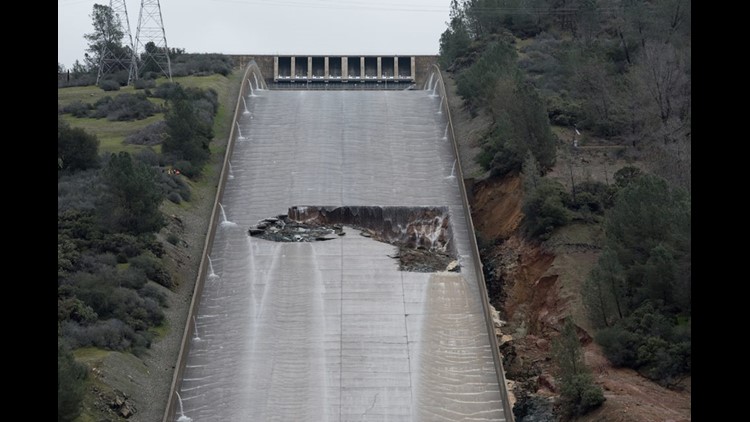OROVILLE, Calif. — State officials charged with managing Oroville Dam created an unprecedented evacuation emergency last February in part by ignoring the advice of technical experts and trying to avoid flooding a powerhouse, an independent investigator concluded in a scathing report released Friday morning.
The Independent Forensic Team Report, after an investigation that stretched through most of last year, also found that the California Department of Water Resources suffers from a bureaucratic, insular culture that hasn't matured to prioritize safety, and that the result has been, in part, a failure to learn from the latest advances in the industry.
"Like many other large dam owners, DWR has been somewhat overconfident and complacent regarding the integrity of its civil infrastructure and has tended to emphasize shorter-term operational considerations," the report said. "Combined with cost pressures, this resulted in strained internal relationships and inadequate priority for dam safety."
But the problems that built up to last February's near-catastrophe also extend all the way back to the construction of Oroville Dam, America's tallest at 742 feet. The spillway cracked almost immediately after construction, the investigators found, but that was never treated as a serious issue.
In addition, they said, dam operators accepted wrong information for decades about the quality of rock beneath the spillway. So they were unprepared for the scale of damage once a slab lifted and water poured into the hole.
The report stops short of laying direct responsibility, however.
"The incident cannot reasonably be 'blamed' mainly on any one individual, group, or organization," the summary says.
In fact, the report's author's issued a stark warning to the entire industry, raising questions for any community downstream of large dams. Many of the Oroville failings apply broadly to dam managers, they wrote.
"The question is whether dam owners, regulators, and other dam safety professionals will recognize that many of these lessons are actually still to be learned. Although the practice of dam safety has certainly improved since the 1970s, the fact that this incident happened to the owner of the tallest dam in the United States, under regulation of a federal agency, with repeated evaluation by reputable outside consultants, in a state with a leading dam safety regulatory program, is a wake-up call for everyone involved in dam safety."
But during a telephone press conference Friday afternoon, John France, leader of the independent team, said communities downstream from dams shouldn't be alarmed and that the situation is not dire.
“If you look at the record of frequency or occurrences of dam incidents, like Oroville, or dam failures, they occur relatively rarely. If you look at U.S. dam safety failures that have cost lives, they happen less frequently. So people should not lose sleep, but they should be concerned about it,” France said.
France emphasized that more resources should be allocated to protect dams, which he says are a valuable part of the country's infrastructure.
“But there is time to do that; we shouldn't wait any longer,” he said. “We should learn from this and we should do better.”
The Independent Forensic Team consists of six experts recommended by the Association of State Dam Safety Officials and the United States Society on Dams. The experts worked under contracts with the state DWR, but, the report says, they acted with complete independence and did not run their findings by DWR for approval before making the report final.
According to a prepared statement by the DWR, the department agreed with the conclusion of the findings, stating that "all dam owners need to reassess current procedures."
“We strongly supported having an independent assessment of the spillway failure and take the findings very seriously,” said DWR Director Grant Davis. “This report is consistent with the independent team's initial technical findings from last May which were fully incorporated in the design of the reconstructed spillways. As we have done in the past, we will carefully assess this report, share it with the entire dam safety community and incorporate the lessons learned going forward to ensure California continues to lead the nation on dam safety.”
France said DWR officials cooperated with his team and never withheld or denied information requests. However, the state agency needs to improve its management system for dam safety information.
“One thing we found was that it was challenging to find the information you want,” France said. “We don't feel . . . that DWR was holding any information back from us; just the information was not organized necessarily in an easy way to find everything.”
DWR officials also stated that the department has already made "significant progress to bolster the dam safety program" by including comprehensive inspections to include "extensive hydrologic, structural a geotechnical work and a thorough investigation of records."
The state agency agreed that the report was a "wake-up call for everyone involved in dam safety."
"During the incident, our sole focus was protecting public safety,” said Joel Ledesma, deputy director of the State Water Project. “DWR supported this independent assessment — so we can learn from the past and continue to improve now and into the future.”
North State Congressman Doug LaMalfa, R-Richvale, also participated in Friday's telephone conference and asked France several questions, including whether France was troubled that older records for Oroville Dam were incomplete or just not there.
“It is troubling in some ways,” France said. “Unfortunately, I have to say it's what we run into a lot. A lot of organizations, what happens is they get pressed for space.”
Those paper documents inside an old filing cabinet taking up room get tossed, France said, because the agency needs more space.
“It is concerning, troubling, but not unusual,” France said.
After the telephone conference, LaMalfa said he will continue to ask the Federal Energy Regulatory Commission to withhold Oroville Dam's re-licensing for a short period of time.
“We need to have time to digest the report and also have some assurances there's going to be a new way of doing business,” LaMalfa said.



